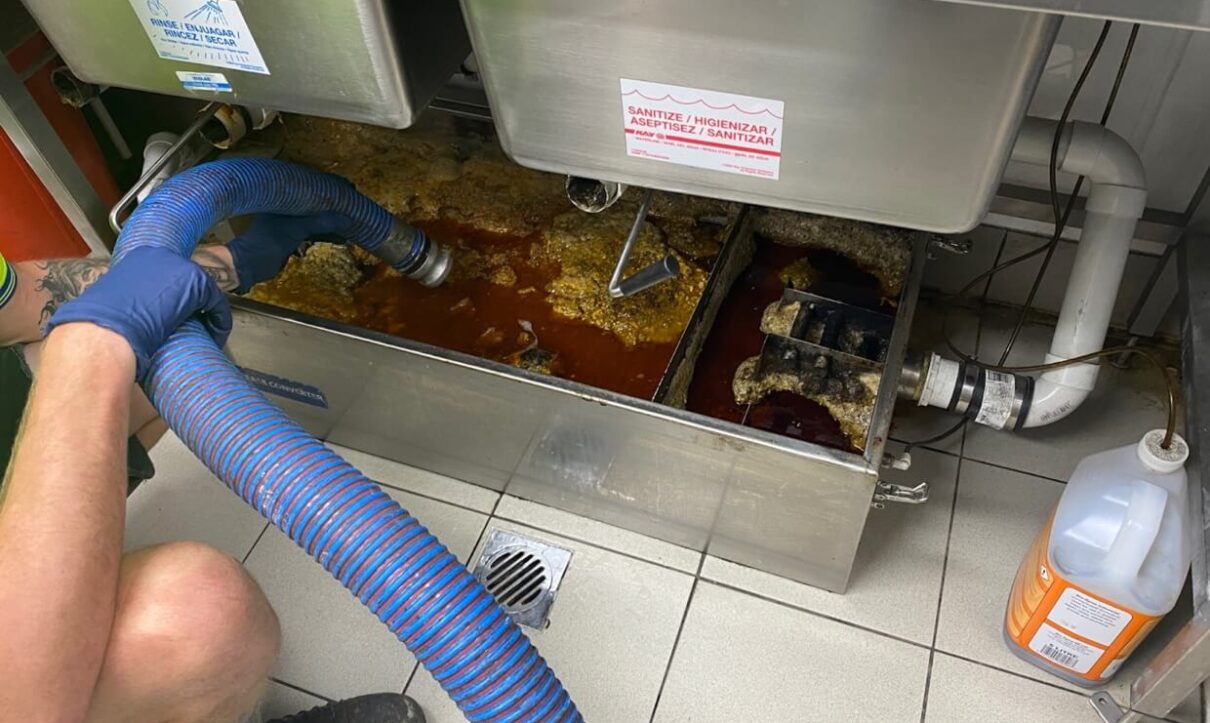
Request A Call Back
Fat, oil, and grease (FOG) build-up reduces the efficiency of your grease trap and can lead to unpleasant odours in your kitchen.
SHS Hygiene can assist with our grease trap cleaning service by removing harmful FOG, cleaning the grease trap itself, and, as a licensed waste carrier, removing the hazardous waste from your site.
This ensures your waste is handled by a fully licensed Hazardous Waste transfer station.
1. Commercial Grease Trap Cleaning
Cleaning grease traps or grease separators can vary depending on the size and type of installation. The size of the trap is determined by either the kitchen type or the kitchen equipment itself and must conform to British Building Regulations BS EN 1825. Grease traps typically fall into two categories:
- The first type is a smaller trap, similar in size to a domestic water tank (50 gallons), typically found inside the kitchen. These are usually housed indoors and, due to the potential for unpleasant odours, may require more frequent cleaning.
- The second type is a much larger grease trap, usually buried underground outside the premises. These larger traps often require cleaning with large truck-mounted pumps, similar to those used for cleaning septic tanks.
2. How often should a grease trap be cleaned?
Grease traps should be cleaned at least every three months. However, busy restaurants and kitchens with multiple fryers, such as fast food establishments, should increase the frequency and clean and service their grease traps every month.
3. How do grease traps work?
A grease trap is a tank or reservoir situated between the kitchen and the public sewer system that separates fats, oils, greases, and food waste from water to prevent them from entering the public sewer system. Fats, oils, and greases float to the top of the tank, while denser solids sink to the bottom. The “clean” water in the middle can then be removed via a filter.
4. Why Commercial Grease Traps are Important?
Cleaning a grease trap in a commercial kitchen rarely inspires anyone, yet it is a crucial part of every commercial kitchen maintenance programme. Failure to regularly maintain and clean your grease trap can result in your premises being closed by Environmental Health. While this task is easy to overlook, neglecting it can lead to serious problems, including the following:
- Blocked or slow flowing drains
Grease from fats, oils, and grease (FOG) enters the system through food waste, food scraps, margarine, butter, cooking oil, and lard, as well as from cleaning crockery, cutlery, and kitchen pots and pans, which can occur multiple times during a single commercial kitchen shift. This issue is sometimes worsened by staff improperly disposing of fats, oils, and grease down the sink, which is illegal. Over time, this waste accumulates and blocks the drainage system, leading to inconvenient, difficult, and expensive clean-ups.
There are many well-documented cases where untreated FOG has formed fatbergs. A fatberg is a large, congealed mass that forms when fats, oils, and greases combine with non-biodegradable materials, such as nappies and baby wipes. In some instances, these fatbergs have grown as large as double-decker buses, weighing up to 40 tonnes.
- Bad smelling drains
When grease traps are not cleaned and maintained, fats, grease, and oils start combining with stagnant or slow-moving water, creating foul smells. These odours, known as “sewer gas,” contain hydrogen sulphide, methane, carbon dioxide, and ammonia. These gases form as materials break down and are extremely unpleasant at low levels and toxic at high levels of exposure.
- Leaks to the Public Sewer system
In addition to being harmful to the environment, the Water Industry Act of 1999 prohibits individuals and businesses from introducing anything into the public sewer system that might impede the flow of waste matter.
5. Legislation on Kitchen Grease Traps
There are three laws relevant to the removal of grease in the United Kingdom.
BBR (British Building Regulations) state that “commercial hot food premises should be fitted with a grease separator complying with BS EN 1825-1:2004 and designed in accordance with BS EN 1825-2:2002 or other effective means of grease removal.
Food Safety Act 1990 empowers Local authorities to inspect premises and any problems arising from the effect of fat, oil and grease on drains, resulting in a failure to comply with the Food Hygiene Regulations, could result in prosecution or an emergency prohibition order preventing trading from the premises. In short this gives the local authority the power to close down any premises they believe is not compliant.
Environmental Protection Act 1990 specifically refers to waste cooking oils and fats stating that commercial premises have a Duty of Care to arrange the safe collection and disposal of FOG. This includes ensuring that any company subcontracted to collect and dispose of the waste must be a registered waste carrier and maintaining documentation to prove this. Even a failure to produce the documents can leave the business open to fines and the recovery of the Local Authorities costs.
6. Grease Trap Cleaning Checklist
We provide a checklist for clients and Facilities Managers to assist with grease trap cleaning and maintenance. This will help you validate compliance with the regulations.
7. How do you Clean a Grease Trap?
- Ensure you are wearing the appropriate PPE and have containers for the safe and legal disposal of the waste materials.
- Scrape off the top layer of fats, oils, and greases into an approved container.
- Remove the water from the trap.
- Remove the solids from the bottom of the trap into an approved container.
- Clean the empty tank with a biodegradable solution.
8. Grease Trap Cleaning Chemicals
Many commercial premises incorporate environmentally friendly chemicals into their grease trap cleaning and maintenance programmes. These include “fat busters,” which break down fats and can be introduced via automated dosing machines. These chemicals assist in breaking down fats and help control any potential odour issues that may arise.
Our Easy 4 Step Process
Get Clean, Safe & Compliant
1. Contact Us
Call us now to speak with one of our cleaning experts today.
- Speak to an Expert
- Fast Response
- Nationwide Service
2. Site Visit
We’ll meet with you on site to inspect the facility & review your options.
- Site Inspection
- Risk Assessment
- Dedicated Account Managers
3. Get Clean
Get perfectly clean & compliant with our certified engineers.
- Minimise Disruption
- All work Certified
- Perfectly Clean
4. Aftercare
Stay clean & compliant, even after our service!
- Be Compliant
- Insurance Approved
- Planned Maintenance Schedule

